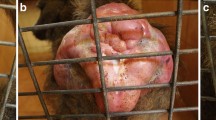Abstract
The odors of female mammals varies with reproductive states. Males can thus detect a female’s receptive status by the odors from the whole body odor, urine, specialized skin glands, or vaginal discharge. Generally, the odors of estrous females are more attractive to males than are the odors of diestrous females (Johnston, 1983; 1985; Lai et al., 1996; Ordinola et al., 1997). In many species, estradiol plays a role in regulating the attractiveness to males of some odor sources (Ferkin and Johnston, 1993; Ferkin et al., 1991).
Access this chapter
Tax calculation will be finalised at checkout
Purchases are for personal use only
Preview
Unable to display preview. Download preview PDF.
Similar content being viewed by others
References
Ebling, F. J., 1977, Hormonal control of mammalian skin glands, in: Chemical Signals in Vertebrates (D. Muller-Schwarze, and M. M. Mozell, eds.), Plenum Press, New York and London, pp. 17–34.
Ferkin, M. H., and Johnston., R. E., 1993, Roles of gonadal hormones in control of five sexually attractive odors of Meadow voles (Microtus pennsylvanicus), Horm. Behav. 27:523–538.
Ferkin, M. H., Gorman, M. R., and Zucker, I., 1991, Ovarian hormones influence odor cues emitted by female meadow voles (Microtus pennsylvanicus), Horm. Behav. 25:572–581.
Johnston, R. E., 1983, Chemical signals and reproductive behavior, in: Pheromone and Reproduction in Mammals (J. G. Vandenbergh, ed.), Academic Press Inc. Orlando, Florida, pp. 3–37.
Johnston, R. E., 1985, Communication, in: The Hamster-Reproduction and Behavior. (H. I. Siegel, ed.), Plenum Press, New York, pp. 121–154
Lai, S., Vasilieva, N. Y., and Johnston, R. E., 1996, Odors providing sexual information in Djungarian hamsters: evidence for an across-odor code, Horm. Behav. 30:26–36.
Müller-Schwarze, D., 1983, Scent gland in mammals and their functions, in : Advances in the Study of Mammalian Behavior (J. F. Eisenberg, and D. G. Kleiman, eds), Special Publications No. 7, The American Society of Mammalogist, pp. 147–191.
Ordinola, P., Martinez-Gomez, M., Manzo, J., and Hudson, R., 1997, Response of male domestic rabbits (Oryctolagus cuniculus) to inguinal gland secretion from intact and ovariectomized females, J. Chem. Ecol., 23:2079–2091.
Wang, S., Yang, H., and Hao, S., 1996, Activity rang, activity rhythm and food preference in ratlike hamsters (Cricetulus triton), Chinese Zool. 31:28–31.(in Chinese)
Wynne-Edwards, K. E., Terranova, P. F., and Lisk, R. D., 1987, Cyclic Djungarian hamsters (Phodopus campbellí) lack the progesterone surge normally associated with ovulation and behavioral receptivity, Endocrinology 120:1308–1316.
Yang, H., Wang, S., and Hao, S., 1996, An investigation on populations of ratlike hamsters (Criccetulus triton), their predication and the integrated management in the non-irrigated area on Huabei Plain, China, in: Theory and Practice of Rodent Pest Management (Z. Wang and Z. Zhang eds.), Science Press, Beijing, China, pp.229–246 (in Chinese).
Zeng, G., Jiang, G., and Wang, H., 1980, Changes of serum LH, estradiol-17ß and progesterone levels in Hu-Yang and Chinese Karakul ewes during the oestrous cycle, Acta Veterinaria Et Zootechnica Sinica 11:147–154 (in Chinese).
Zhang, J., 1997, Chemical communication in ratlike hamsters (Cricetulus triton), Unpubl. Ph.D. dissert., Institute of Zoology, Chinese Academy of Sciences, Beijing, China (in Chinese).
Zhang, J., Zhang, Z., and Wang, Z., 1999a, Behavioral interactions and mating behavior of ratlike hamsters (Cricetulus triton) during breeding season, Acta Theriologica Sinica 19(2): 132–142 (in Chinese).
Zhang, J., Zhang, Z., and Wang, Z., 1999b, Development and sexual differences in flank glands of rat-like hamsters (Cricetulus triton), Acta Zool. Sinica 45:390–397.
Author information
Authors and Affiliations
Editor information
Editors and Affiliations
Rights and permissions
Copyright information
© 2001 Springer Science+Business Media New York
About this chapter
Cite this chapter
Zhang, JX., Zhang, ZB., Wang, ZW. (2001). Males’ Olfactory Discrimination of Receptive State of Females in Rat-Like Hamsters (Cricetulus Triton). In: Marchlewska-Koj, A., Lepri, J.J., Müller-Schwarze, D. (eds) Chemical Signals in Vertebrates 9. Springer, Boston, MA. https://doi.org/10.1007/978-1-4615-0671-3_52
Download citation
DOI: https://doi.org/10.1007/978-1-4615-0671-3_52
Publisher Name: Springer, Boston, MA
Print ISBN: 978-1-4613-5187-0
Online ISBN: 978-1-4615-0671-3
eBook Packages: Springer Book Archive



